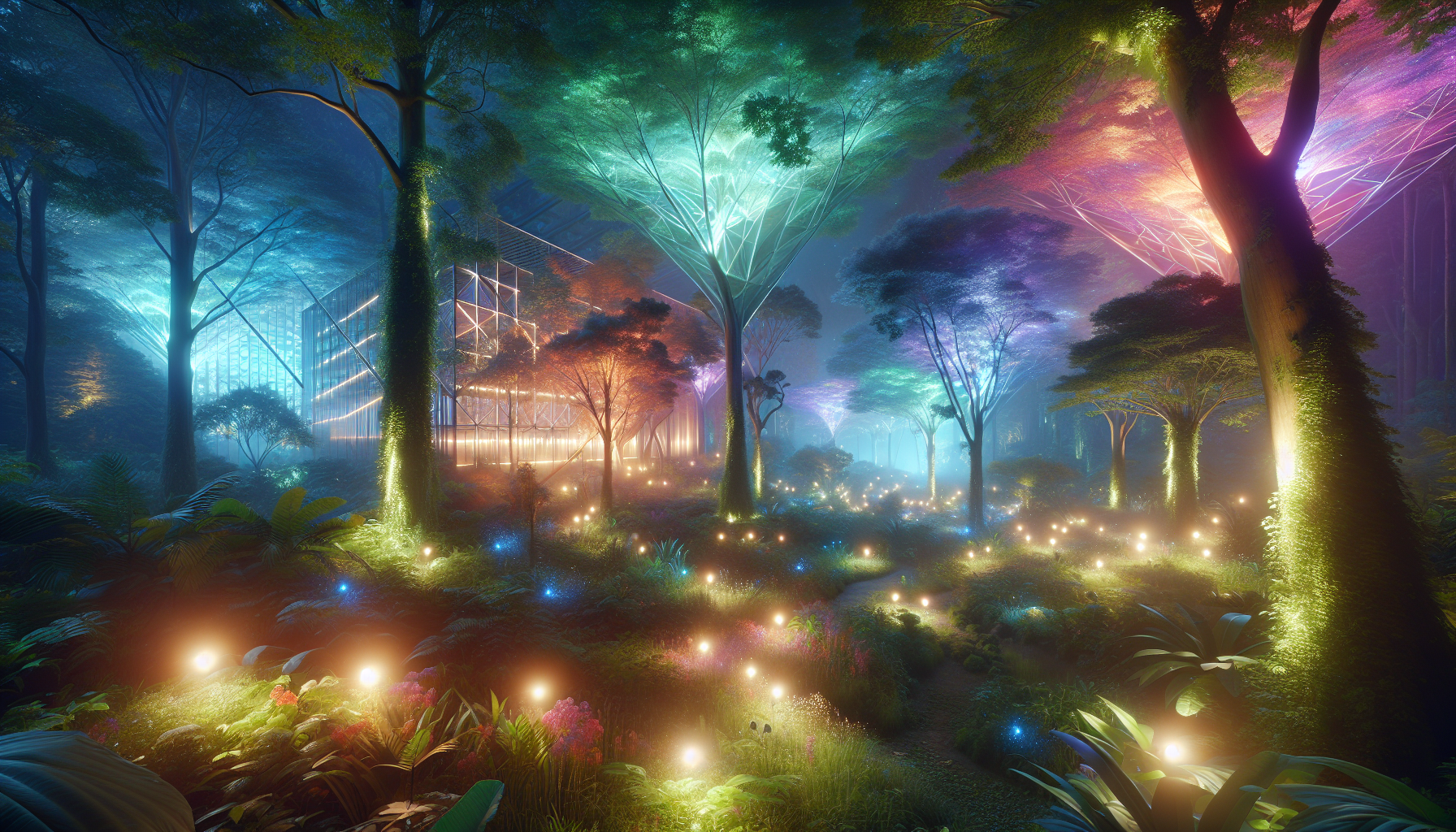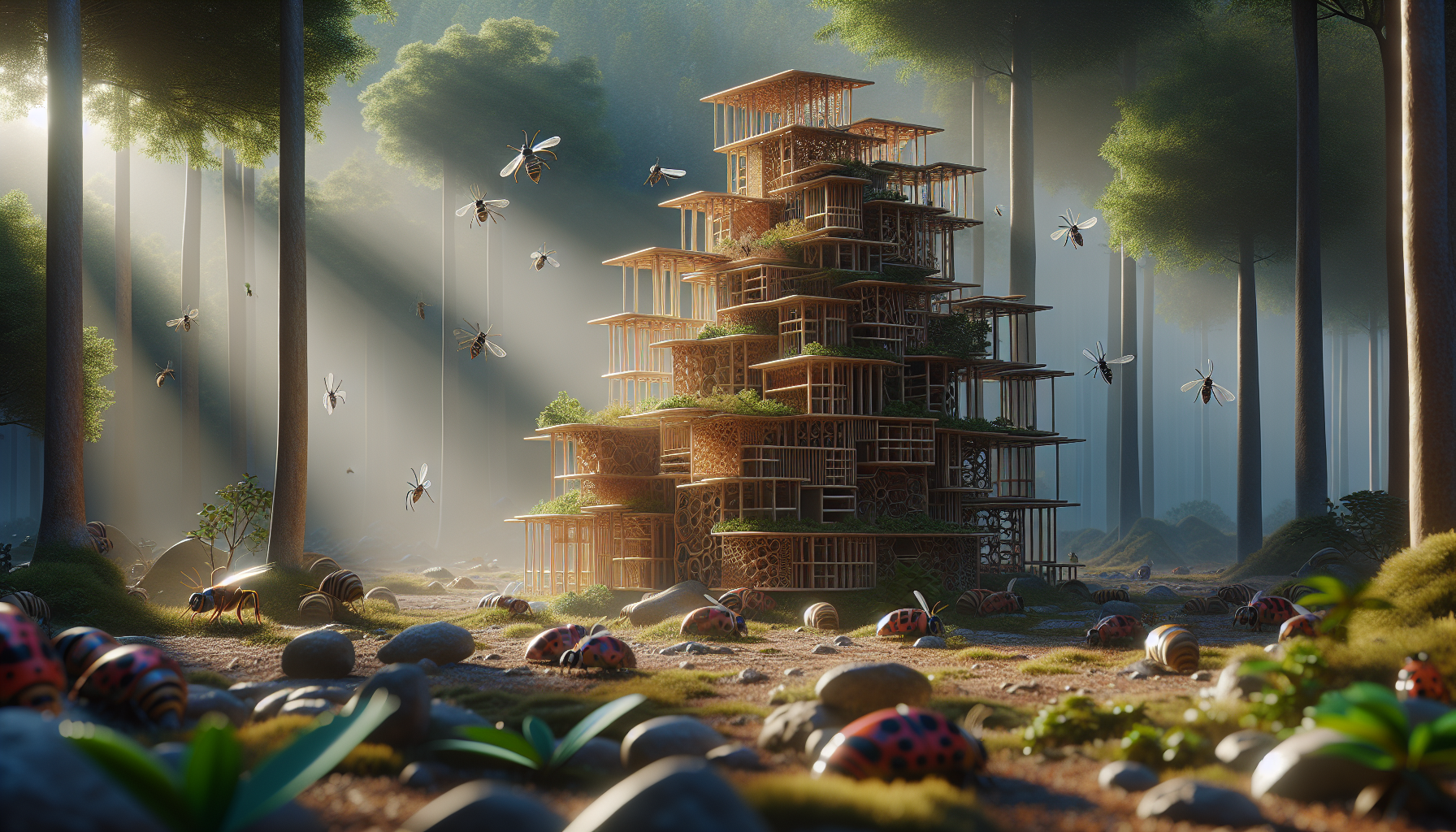In the gentle glow of dusk, when the last rays of the sun melt into the embrace of night, an enchanting spectacle unfolds. Tiny luminescent creatures, with their sporadic flickers, turn gardens into magical realms. Fireflies, the stars of this nightly show, captivate both young and old with their mesmerizing dance. But beyond their beauty, these insects play a vital role in our ecosystem. Imagine having a haven in your backyard that not only attracts these dazzling performers but also supports an array of beneficial insects, transforming your garden into a vibrant oasis of life. Welcome to the world of “Firefly Haven: Ingenious Microstructures Tailored to Attract Your Favorite Insects!” 🌿✨
As urbanization expands and natural habitats dwindle, many insects face the looming threat of extinction. Yet, they are crucial allies in maintaining ecological balance. From pollinators like bees and butterflies to natural pest controllers like ladybugs and lacewings, each insect plays a unique role. Fireflies, besides enchanting us with their glow, contribute to pest control by feeding on slugs and snails during their larval stage. This article explores how we can create microstructures in our gardens to welcome these vital creatures, blending aesthetics with functionality to foster biodiversity right at our doorstep.
Imagine stepping into your garden and witnessing a symphony of insect activity. The hum of bees, the flutter of butterfly wings, and the gentle glow of fireflies create a living tapestry that is as beneficial as it is beautiful. By crafting specific microstructures, you can invite this symphony into your space. We will delve into the art and science of designing these habitats, exploring the materials and layouts that attract different insects. From the towering elegance of bee hotels to the understated charm of firefly ponds, each structure serves a purpose, supporting the lifecycle of the insects they are designed for.
Creating a Firefly Haven isn’t just about attracting insects; it’s about fostering an environment where they can thrive. This article will guide you through the process of selecting the right plants, understanding the needs of different insect species, and arranging your garden to maximize its ecological impact. We’ll discuss how to strike a balance between natural beauty and environmental responsibility, ensuring that your garden serves as a sustainable sanctuary. You’ll learn how to monitor and maintain these microstructures, adapting them as needed to cater to seasonal changes and the shifting needs of your garden’s inhabitants.
## Understanding Firefly Haven: Ingenious Microstructures
Creating a garden that attracts your favorite insects can transform your outdoor space into a haven of biodiversity and beauty. With a particular focus on fireflies, these ingenious microstructures serve as a refuge and habitat for various beneficial insects. By understanding the principles behind these structures and implementing them in your garden, you can foster an environment that not only supports local wildlife but also enhances your garden’s aesthetic appeal.
Fireflies, or lightning bugs, are more than just a fascinating spectacle on summer nights. They play a crucial role in the ecosystem as pollinators and as part of the food chain. Their presence in your garden indicates a healthy environment, free of pesticides and rich in native plants. The construction of Firefly Haven structures involves considering the microhabitats these insects prefer, such as moist, warm areas with abundant vegetation and minimal artificial light. By catering to these needs, you can create a welcoming environment for fireflies and other beneficial insects.
### The Science Behind Microstructures
The design and functionality of microstructures are grounded in scientific principles that cater to the behavioral patterns and ecological requirements of fireflies. These structures are designed to mimic natural habitats, providing shelter and resources that are critical for the survival and reproduction of these insects. Understanding the specific needs of fireflies helps in constructing effective microhabitats.
Firstly, microstructures should be situated in areas with reduced light pollution. Fireflies use bioluminescence to communicate during mating, and artificial lights can disrupt these signals. Thus, placing your microstructure away from streetlights or other light sources is crucial. Moreover, these structures should include materials and designs that maintain high humidity levels, as fireflies thrive in moist environments. This can be achieved through strategic planting and the incorporation of water features.
Additionally, the use of native plants in these microstructures is paramount. Native plants are adapted to the local climate and soil, and they provide the best resources for local wildlife, including fireflies. Planting a variety of flowering plants ensures a steady supply of nectar and pollen throughout the year, supporting not only fireflies but also a host of other beneficial insects.
### Designing Your Firefly Haven
Designing a Firefly Haven involves creativity and a deep understanding of ecological interactions. The aim is to create a balanced ecosystem that attracts and supports fireflies along with other beneficial insects. The design process includes selecting the right plants, structuring the microhabitats, and maintaining the garden.
1. **Selecting the Right Plants**: Choose a mix of flowering plants, shrubs, and trees that provide nectar and shelter. Native plants are ideal as they are well-suited to the local environment and attract native insect species.
2. **Structuring the Microhabitats**: Incorporate different layers in your garden to mimic natural habitats. This includes ground covers, mid-layer shrubs, and taller trees. Each layer supports different insect communities, creating a diverse and dynamic ecosystem.
3. **Maintaining the Garden**: Regular maintenance is essential to keep the garden healthy and attractive to insects. This involves pruning, weeding, and ensuring that plants have adequate water and nutrients. Avoid the use of pesticides as they can harm fireflies and other beneficial insects.
Here’s a comparative table to help you choose the right plants for your Firefly Haven:
| Plant Type | Examples | Benefits |
|---|---|---|
| Flowering Plants | Goldenrod, Aster | Provides nectar and pollen for insects |
| Shrubs | Sumac, Spicebush | Offers shelter and food sources |
| Trees | Oak, Willow | Creates shade and habitat layers |
### Microhabitat Features to Include
Creating the ideal Firefly Haven involves incorporating specific features that cater to the needs of fireflies and other insects. Below are some essential features to consider:
– **Water Sources**: Water is crucial for maintaining the high humidity levels that fireflies prefer. Incorporate small ponds or birdbaths, ensuring they are shallow enough to prevent drowning of insects.
– **Decaying Organic Matter**: Fireflies often lay eggs in moist soil rich in organic material. Adding leaf litter, compost, or mulch can create the perfect breeding ground for these insects.
– **Natural Lighting**: Minimize artificial lighting in your garden to prevent disruption of firefly mating rituals. Opt for dim, solar-powered lights or use motion-activated lights that only turn on when necessary.
– **Shelter and Hiding Spots**: Incorporate logs, rocks, and dense plantings to provide hiding spots for insects. These structures offer protection from predators and harsh weather conditions.
Here’s a helpful video for designing insect-friendly gardens: “How to Create an Insect-Friendly Garden” by Lovely Greens on YouTube.
### Challenges and Solutions
Creating a Firefly Haven may present several challenges, but with the right strategies, these can be overcome. One common challenge is dealing with pests without using pesticides. Pesticides can kill not only pests but also beneficial insects like fireflies. Instead, consider alternative pest management strategies, such as introducing natural predators or using organic repellents.
Another challenge is maintaining the right balance of moisture and light. While fireflies need moist environments, excessive water can lead to mold and other plant diseases. Proper drainage and choosing the right plants can help maintain the necessary balance. Similarly, while reducing artificial light is essential, ensuring safety and visibility in your garden is also crucial. Use shields or timers to manage light exposure effectively.
### Promoting Biodiversity
Encouraging a variety of insects in your Firefly Haven is beneficial for your garden’s health and biodiversity. A diverse insect population can lead to a more resilient ecosystem, capable of withstanding pests and diseases. Here are some strategies to promote biodiversity:
- Plant Diversity: Incorporate a wide variety of plant species to attract different insect types. Each plant will support different insects, from pollinators to predators.
- Habitat Complexity: Create various microhabitats within your garden, including shaded areas, open spaces, and water features. This diversity in habitats will support a broader range of insect species.
- Seasonal Interest: Ensure that your garden provides resources throughout the year. Plant species that bloom in different seasons to maintain a continuous supply of food for insects.
### Conclusion
In conclusion, “Firefly Haven: Ingenious Microstructures Tailored to Attract Your Favorite Insects” brings to light a fascinating and often overlooked aspect of nature’s delicate intricacies. The article has taken you on a journey through the captivating world of microstructures designed to attract specific insects, focusing primarily on the enchanting fireflies. By exploring these microstructures, we have unveiled the sophisticated mechanisms that these tiny architects employ to allure their desired visitors.
Firstly, we delved into the anatomy and behavior of fireflies, highlighting their unique bioluminescence and the pivotal role it plays in communication and mating. This natural phenomenon is not just a spectacle to behold but also a critical component of their survival strategy. Understanding this allows us to appreciate the intricate balance within ecosystems and the importance of preserving such natural wonders.
Next, we explored the innovative designs of microstructures that mimic the firefly’s environment, enhancing their attraction and supporting their lifecycle. These structures are not only engineering marvels but also serve as a testament to human ingenuity in biomimicry. By adopting these designs, we not only facilitate the flourishing of firefly populations but also contribute to biodiversity and ecological health. The importance of these structures extends beyond aesthetics; they represent a fusion of art and science with tangible benefits for the environment.
Furthermore, we discussed the broader implications of implementing such structures in urban and rural settings. By creating habitats that support fireflies and other beneficial insects, we can significantly enhance local biodiversity. This, in turn, supports pollination and pest control, providing a sustainable and organic solution to many agricultural challenges. Encouraging the presence of these insects can lead to healthier gardens and farms, ultimately benefiting food production and human well-being.
We also touched upon the potential for educational opportunities. Implementing firefly microstructures can serve as a practical learning tool, inspiring curiosity and fostering a deeper connection with nature. Schools, community gardens, and parks can use these structures to teach about ecology, biology, and environmental stewardship, encouraging future generations to value and protect their natural surroundings.
The topic of firefly microstructures is not just an academic or ecological concern; it is a call to action for individuals and communities. By understanding and implementing these ingenious designs, we can play an active role in conserving our natural heritage. Whether you are an avid gardener, an educator, or simply a nature enthusiast, there are numerous ways to get involved.
We encourage you to reflect on the insights shared in this article and consider how you can contribute to this endeavor. Perhaps you can start by designing a firefly-friendly space in your garden or supporting local initiatives aimed at enhancing insect habitats. Share this knowledge with friends and family, sparking conversations about the importance of biodiversity and the small changes we can make to support it. 🌿
As we conclude this exploration, remember that each small action counts. By fostering environments that attract and support insects like fireflies, we contribute to a larger movement of environmental preservation and sustainability. Let this inspire you to continue learning and advocating for a world where nature and humanity coexist harmoniously.
We invite you to share your thoughts and experiences in the comments below. Have you observed fireflies in your area, or have you implemented any structures to attract them? Your insights could inspire others to take action, creating a ripple effect of positive change. Feel free to share this article with your network, spreading the word about the importance of microstructures in supporting insect populations. Together, we can illuminate the path toward a more sustainable future, one firefly at a time. ✨
For further reading and resources on how to create your own firefly-friendly habitats, check out [National Wildlife Federation’s guide](https://www.nwf.org/Garden-for-Wildlife/About/Native-Plants/Firefly-Habitat) and [The Xerces Society’s tips on pollinator conservation](https://xerces.org/pollinator-conservation). These sources provide practical advice and detailed information on fostering environments that benefit fireflies and other essential insects.
Thank you for joining us on this enlightening journey through the world of firefly microstructures. May it inspire you to take action and cherish the wonders of nature that light up our lives.
Toni Santos is a visionary artisan and conceptual designer who channels the beauty of living organisms into structural expression. At Zureste, Toni explores the intricate elegance of insect anatomy, organic flow, and bioinspired design to create art that feels both natural and otherworldly.
Each creation Toni brings to life reflects a harmonic tension between structure and softness, wildness and control — echoing the complex intelligence found in the natural world. From beetle-like silhouettes to root-shaped contours, his work blurs the lines between biology, sculpture, and modern art.
Guided by fascination for metamorphosis, evolution, and pattern in nature, Toni’s pieces embody transformation. His BioLight Collection and conceptual series like Insect Type and Structure Aesthetics offer viewers more than aesthetic value — they present immersive experiences of living design.
As the creative force behind Zureste, Toni invites us to rethink beauty, architecture, and identity through a new lens — one shaped by wings, bones, spirals, and the microscopic poetry of the organic.
🌿 His creations reflect:
-
Design deeply rooted in the geometry of life
-
Inspiration from insects, roots, and the unseen natural order
-
A blend of science, spirituality, and visual storytelling
Whether you’re a lover of strange beauty, an admirer of evolution’s artistry, or a creative mind seeking something different, Toni welcomes you into a world where living forms become meaning, and surreal becomes sublime.





